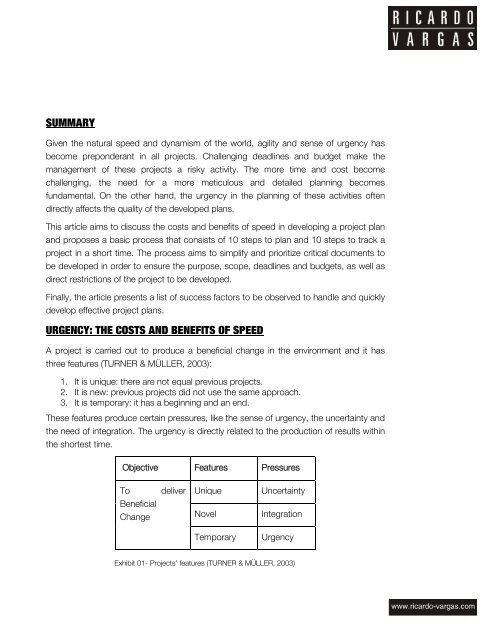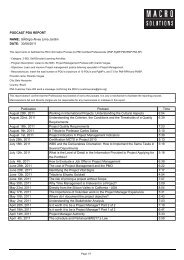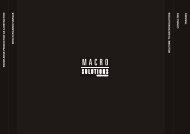urgency: a critical factor in project planning - Ricardo Vargas
urgency: a critical factor in project planning - Ricardo Vargas
urgency: a critical factor in project planning - Ricardo Vargas
You also want an ePaper? Increase the reach of your titles
YUMPU automatically turns print PDFs into web optimized ePapers that Google loves.
SUMMARY<br />
Given the natural speed and dynamism of the world, agility and sense of <strong>urgency</strong> has<br />
become preponderant <strong>in</strong> all <strong>project</strong>s. Challeng<strong>in</strong>g deadl<strong>in</strong>es and budget make the<br />
management of these <strong>project</strong>s a risky activity. The more time and cost become<br />
challeng<strong>in</strong>g, the need for a more meticulous and detailed plann<strong>in</strong>g becomes<br />
fundamental. On the other hand, the <strong>urgency</strong> <strong>in</strong> the plann<strong>in</strong>g of these activities often<br />
directly affects the quality of the developed plans.<br />
This article aims to discuss the costs and benefits of speed <strong>in</strong> develop<strong>in</strong>g a <strong>project</strong> plan<br />
and proposes a basic process that consists of 10 steps to plan and 10 steps to track a<br />
<strong>project</strong> <strong>in</strong> a short time. The process aims to simplify and prioritize <strong>critical</strong> documents to<br />
be developed <strong>in</strong> order to ensure the purpose, scope, deadl<strong>in</strong>es and budgets, as well as<br />
direct restrictions of the <strong>project</strong> to be developed.<br />
F<strong>in</strong>ally, the article presents a list of success <strong>factor</strong>s to be observed to handle and quickly<br />
develop effective <strong>project</strong> plans.<br />
URGENCY: THE COSTS AND BENEFITS OF SPEED<br />
A <strong>project</strong> is carried out to produce a beneficial change <strong>in</strong> the environment and it has<br />
three features (TURNER & MÜLLER, 2003):<br />
1. It is unique: there are not equal previous <strong>project</strong>s.<br />
2. It is new: previous <strong>project</strong>s did not use the same approach.<br />
3. It is temporary: it has a beg<strong>in</strong>n<strong>in</strong>g and an end.<br />
These features produce certa<strong>in</strong> pressures, like the sense of <strong>urgency</strong>, the uncerta<strong>in</strong>ty and<br />
the need of <strong>in</strong>tegration. The <strong>urgency</strong> is directly related to the production of results with<strong>in</strong><br />
the shortest time.<br />
Objective Features Pressures<br />
To<br />
deliver<br />
Unique<br />
Uncerta<strong>in</strong>ty<br />
Beneficial<br />
Change<br />
Novel<br />
Integration<br />
Temporary<br />
Urgency<br />
Exhibit 01- Projects’ features (TURNER & MÜLLER, 2003)





